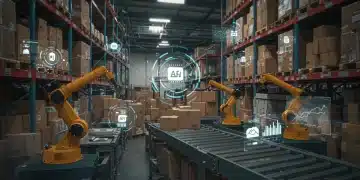Optimizing Energy Consumption with AI: 10% Savings for US Industries by 2025

US industries are on track to achieve a 10% reduction in energy consumption by 2025, driven by the rapid adoption of artificial intelligence in energy management and operational processes.
Breaking news reveals a significant push within US industries to harness artificial intelligence for unprecedented energy efficiency. The ambitious goal is a 10% savings for US industries in 2025, a target now appearing increasingly attainable as AI technologies mature and become more integrated into operational frameworks. This development marks a pivotal moment for both economic competitiveness and environmental stewardship across the nation’s industrial landscape.
The AI Revolution in Industrial Energy Management
The industrial sector, historically a major energy consumer, is currently undergoing a transformative shift. Artificial intelligence is emerging as the primary catalyst for this change, offering sophisticated tools to monitor, analyze, and optimize energy usage at an granular level. This revolution is not merely about incremental improvements but about redefining how industries perceive and manage their energy footprint.
Leading companies are deploying AI systems that learn from vast datasets, identifying patterns and anomalies in energy consumption that human analysis often misses. These systems can predict future energy needs, recommend optimal operational adjustments, and even automate processes to reduce waste. The immediate impact is a visible reduction in utility costs, propelling profitability and sustainability goals simultaneously.
Predictive Analytics for Peak Performance
One of AI’s most powerful applications in energy management is its ability to perform predictive analytics. This involves using historical and real-time data to forecast energy demand and supply, allowing facilities to adjust operations proactively.
- Demand Forecasting: AI algorithms accurately predict future energy requirements based on production schedules, weather patterns, and market prices.
- Equipment Maintenance: By analyzing sensor data, AI can foresee equipment failures, enabling preventative maintenance that avoids costly downtime and inefficient operation.
- Resource Allocation: Optimizing the allocation of energy resources across different production lines or facilities to minimize overall consumption.
Real-time Monitoring and Control
AI-powered systems provide continuous, real-time monitoring of energy usage across an entire industrial complex. This constant oversight ensures that any deviations from optimal performance are immediately flagged and addressed, preventing energy waste before it escalates.
These systems integrate with existing infrastructure, from HVAC and lighting to heavy machinery, creating a cohesive network where every energy-consuming component is intelligently managed. The result is a dynamic environment where energy use is not static but constantly adapted to current operational needs and external conditions.
Driving a 10% Reduction: The 2025 Target
The ambitious goal of a 10% reduction in energy consumption by 2025 is not arbitrary. It reflects a growing understanding among US industrial leaders that significant savings are not only possible but imperative for future competitiveness. This target is being championed by industry consortiums and supported by governmental initiatives aiming for a greener economy.
Achieving this substantial reduction requires more than just implementing new technology; it demands a cultural shift towards data-driven decision-making and continuous optimization. Companies are investing heavily in AI infrastructure, training their workforce, and forming strategic partnerships with AI solution providers. The momentum is building, and early adopters are already reporting impressive results, setting a precedent for others to follow.
Governmental Support and Incentives
Federal and state governments are playing a crucial role in accelerating AI adoption for energy efficiency. Various programs offer incentives, grants, and tax breaks for companies investing in smart energy technologies. These initiatives aim to de-risk the initial investment for industries, making the transition to AI-driven energy management more attractive.
- Tax Credits: Providing financial relief for the purchase and installation of energy-efficient AI systems.
- Research Grants: Funding for innovative AI solutions tailored for specific industrial energy challenges.
- Educational Programs: Supporting workforce development to equip employees with the skills needed to manage AI-powered systems.
Industry Collaboration and Best Practices
Collaboration across industries is also vital. Forums and associations are facilitating the sharing of best practices, case studies, and technological advancements. This collective effort ensures that lessons learned by one industry can benefit others, accelerating the overall pace of energy optimization.
The exchange of knowledge helps in identifying common challenges and developing standardized solutions, further streamlining the implementation of AI-based energy management systems. This collaborative approach is critical for reaching the 2025 target efficiently and effectively.
Key AI Technologies Powering Energy Efficiency
Several cutting-edge AI technologies are at the forefront of this energy optimization drive. These technologies work in concert to provide a comprehensive solution for reducing industrial energy footprints. From machine learning algorithms to advanced sensor networks, the tools are becoming increasingly sophisticated and accessible.
The integration of these technologies allows for a holistic approach to energy management, moving beyond simple automation to intelligent self-optimization. This level of control and insight was previously unimaginable, offering industries an unprecedented opportunity to manage their resources more effectively.

Machine Learning for Pattern Recognition
Machine learning algorithms are fundamental to AI-driven energy efficiency. They excel at processing vast amounts of data to identify complex patterns and correlations that influence energy consumption. This includes everything from subtle fluctuations in machine performance to environmental factors.
- Anomaly Detection: Quickly identifying unusual energy spikes or drops that could indicate equipment malfunction or waste.
- Optimization Algorithms: Developing models that recommend the most energy-efficient settings for machinery and processes.
- Predictive Maintenance: Using ML to predict when equipment is likely to fail, allowing for proactive repairs that prevent energy-intensive breakdowns.
Internet of Things (IoT) Integration
The IoT forms the backbone of data collection for AI systems. Sensors embedded in industrial equipment, buildings, and infrastructure continuously gather real-time data on temperature, pressure, vibration, electricity usage, and more. This torrent of information feeds the AI algorithms, providing the raw material for intelligent analysis.
Without robust IoT networks, AI’s ability to optimize energy would be severely limited. The seamless flow of data from physical assets to digital platforms is what enables AI to have a tangible impact on energy consumption. This interconnectedness is a defining feature of modern smart industries.
Case Studies: Early Successes and Scalability
While the 10% savings target for 2025 is ambitious, numerous early success stories demonstrate the tangible benefits of AI in energy optimization. These case studies provide compelling evidence of AI’s scalability and effectiveness across diverse industrial sectors, from manufacturing to data centers.
These initial successes are crucial for building confidence and accelerating broader adoption. They showcase not only the potential for significant energy reductions but also improvements in operational efficiency, reduced maintenance costs, and enhanced sustainability profiles.
Manufacturing Sector Innovations
In the manufacturing sector, AI is being used to optimize production line scheduling, furnace temperatures, and motor speeds. A major automotive manufacturer, for instance, reported a 7% reduction in energy costs within a year by implementing an AI system that fine-tuned its painting and assembly processes.
Another example comes from a chemical plant that utilized AI to optimize its distillation columns, notoriously energy-intensive processes. The AI system analyzed real-time sensor data and adjusted parameters, leading to a 5% energy saving in that specific operation, equating to millions of dollars annually.
Data Centers and HVAC Optimization
Data centers, known for their massive energy requirements, are also seeing significant gains. Google, a pioneer in AI for data center management, famously reported a 40% reduction in cooling energy consumption by using AI to predict and manage its cooling systems. This translates into substantial overall energy savings for their facilities.
Similar applications are being deployed in commercial and industrial HVAC systems, where AI algorithms learn building occupancy patterns, external weather conditions, and internal heat loads to provide optimal heating and cooling with minimal energy expenditure. This results in both energy savings and improved comfort.
Challenges and the Path Forward
Despite the promising outlook, the journey to widespread AI adoption for energy optimization is not without its challenges. These include the initial investment costs, the need for specialized skills, and the integration of new technologies with legacy systems. Addressing these hurdles is crucial for achieving the 2025 target.
However, the long-term benefits, both economic and environmental, far outweigh these initial difficulties. The path forward involves strategic planning, continued investment in research and development, and fostering an ecosystem that supports innovation and collaboration.
Data Security and Privacy Concerns
As AI systems collect and process vast amounts of operational data, concerns about data security and privacy naturally arise. Industries must implement robust cybersecurity measures to protect sensitive information from breaches and unauthorized access. Ensuring the integrity and confidentiality of data is paramount for the successful deployment of AI.
Companies are investing in secure cloud platforms and edge computing solutions to manage data, alongside stringent access controls and encryption protocols. Adherence to regulatory compliance standards, such as GDPR and CCPA, is also a critical consideration in data handling.
Workforce Training and Skill Gap
The integration of AI necessitates a skilled workforce capable of managing, maintaining, and developing these advanced systems. There is currently a skill gap in areas such as data science, AI engineering, and industrial automation. Bridging this gap through education and training programs is essential.
Universities, vocational schools, and corporate training initiatives are working to develop curricula that address these emerging needs. Upskilling existing employees and attracting new talent with relevant expertise will be key to unlocking the full potential of AI in energy optimization.
The Economic and Environmental Impact
The successful implementation of AI for energy optimization will yield profound economic and environmental benefits for US industries. Economically, reduced energy costs directly boost profitability and competitiveness, allowing companies to reallocate resources towards innovation and growth.
Environmentally, a 10% reduction in industrial energy consumption would significantly lower greenhouse gas emissions, contributing substantially to national and global climate goals. This dual impact makes AI-driven energy efficiency a critical component of a sustainable and prosperous future.
Boosting Competitiveness and Profitability
Lower operating costs due to energy savings directly translate into improved profit margins. This financial advantage allows US industries to compete more effectively on a global scale, where energy efficiency is increasingly a differentiator. Companies can invest these savings back into their businesses, fostering innovation and creating new jobs.
Furthermore, demonstrating a commitment to sustainability through reduced energy consumption enhances a company’s brand reputation, attracting environmentally conscious consumers and investors. This creates a positive feedback loop, driving further investment in green technologies.
Contributing to Climate Goals
From an environmental perspective, a 10% energy reduction in a sector as large as US industry is a monumental step towards combating climate change. It reduces the reliance on fossil fuels, decreases carbon footprints, and contributes to cleaner air and water.
This push for energy efficiency aligns with broader national and international efforts to transition to a low-carbon economy. AI is not just an economic tool but a powerful ally in the fight against environmental degradation, offering practical solutions for a more sustainable future.
| Key Point | Brief Description |
|---|---|
| 10% Savings Target | US industries aim to cut energy consumption by 10% by 2025 using AI. |
| AI Technologies | Machine Learning, IoT, and predictive analytics are central to optimization. |
| Economic Impact | Reduced costs, increased profitability, and enhanced global competitiveness. |
| Environmental Benefits | Significant reduction in greenhouse gas emissions and a greener economy. |
Frequently Asked Questions About AI Energy Optimization
The main objective is to achieve a 10% reduction in energy consumption across US industries by 2025. AI systems monitor, analyze, and optimize energy usage in real-time, leading to significant cost savings and environmental benefits by identifying inefficiencies and automating adjustments.
AI optimizes manufacturing by using machine learning to predict demand, fine-tune production schedules, and adjust machinery settings. This minimizes waste and ensures equipment operates at peak energy efficiency, preventing costly downtime and reducing overall energy expenditure effectively.
Key technologies include machine learning for pattern recognition, Internet of Things (IoT) for real-time data collection from sensors, and predictive analytics. These work together to provide comprehensive insights and automate energy management decisions, enhancing efficiency across industrial operations.
Industries gain significant economic benefits, including reduced operational costs, increased profitability, and enhanced global competitiveness. These savings can be reinvested into research and development, fostering innovation and sustainable growth, while also improving corporate reputation globally.
Challenges include high initial investment costs for AI infrastructure, ensuring robust data security and privacy, and addressing the skill gap in data science and AI engineering. Overcoming these requires strategic planning, continuous investment, and comprehensive workforce training programs.
Looking Ahead
The push to achieve Optimizing Energy Consumption with AI: A Path to 10% Savings for US Industries in 2025 is more than just a fleeting trend; it represents a fundamental shift in industrial operations. As AI technologies continue to evolve, we can expect even more sophisticated solutions to emerge, further refining energy management practices. The next few years will likely see increased collaboration between technology providers and industrial leaders, driving innovation and setting new benchmarks for efficiency and sustainability. This ongoing evolution will be critical in shaping a more resilient and environmentally responsible industrial future for the United States.





